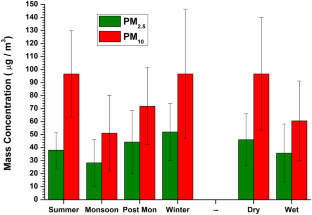Significant abundances of alkaline components in the fine and coarse aerosols over a tropical rain shadow location in peninsular India
Abstract
This paper reports the chemistry of fine (PM2.5) and coarse (PM10) aerosols sampled over a period of three years during 2018–2021 at a semi -arid tropical location in the rain shadow region of the peninsular India. The data is classified in to dry (December to May) and wet (June to November) periods. Scavenging effect due to rains have culminated in to less concentrations of both fine and coarse aerosols and their ionic components in the wet period. Significantly high concentrations of the crustal components such as Ca, Na, K and Mg from the local dust resulted in the alkaline pH in both dry and wet periods with Ca and Mg emerging as major neutralizing components. Overall, < 20% samples of both fine and coarse aerosols depicted acidic pH. Concentration of SO4 was comparatively more than NO3 indicating towards more presence of stationary sources (industrial/domestic emissions) than mobile (vehicular emissions) sources. Combustion generated and highly absorbing black carbon aerosols showed high concentration during the dry period. Local activities comprising residential, agricultural, vehicular and industrial emissions were the major sources of aerosols at Solapur however, the contribution from the distant sources were also found to contribute as inferred from the cluster analysis and concentration weighted trajectories (CWT). The observed abundances of the alkaline dust aerosols that could act as cloud condensation nuclei or ice nuclei will have important implications on the studies related to cloud aerosol precipitation interaction over this region.


 求助内容:
求助内容: 应助结果提醒方式:
应助结果提醒方式:


